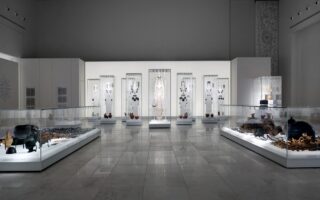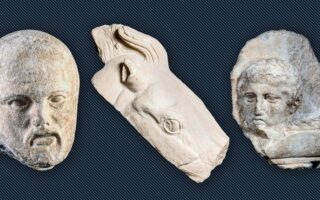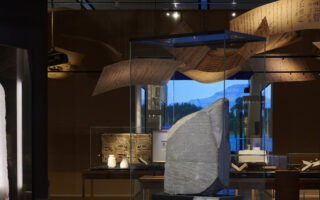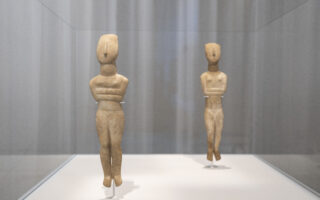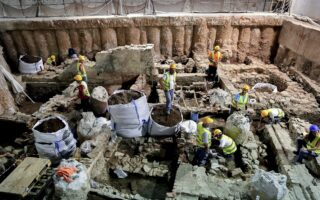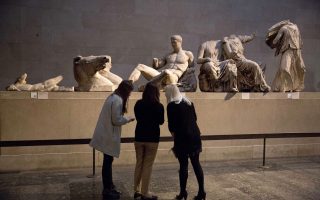A gateway to Vergina’s ancient treasures
The new Polycentric Museum of Aigai in northern Greece opens its doors with an exhibition of sculptures, coins and contemporary works
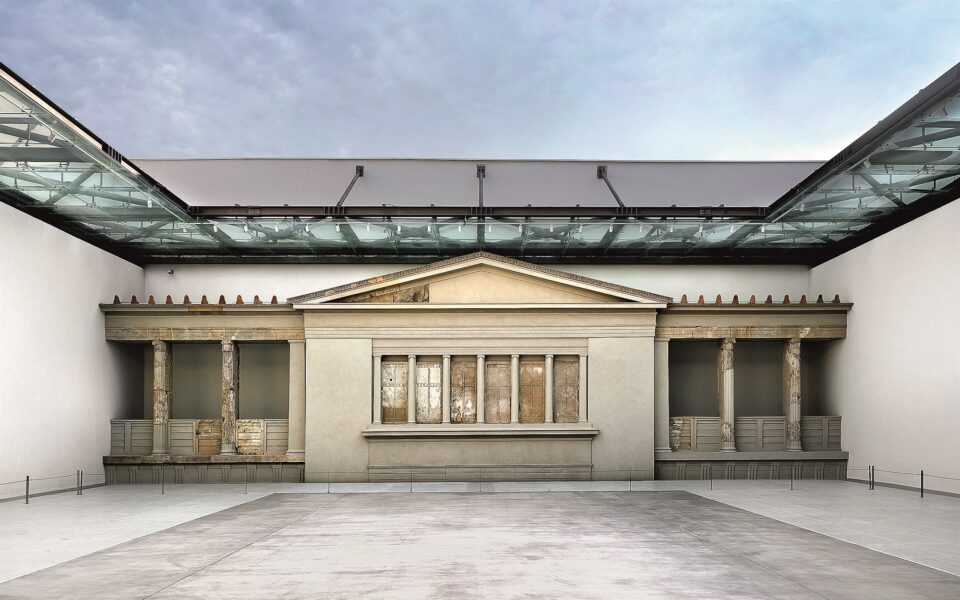
The large, long-anticipated new museum at ancient Aigai, in northern Greece, opened its doors this week with the exhibition “Memories of Aigai,” showcasing finds from the excavations at Vergina. The new space incorporates and unites the new central building with the entire archaeological site, including the Palace of Philip II, the Royal Tombs cluster and the Museum of the Royal Tombs.
Τhe museum aims to serve as a gateway into the history of Aigai, the royal metropolis of the Macedonians, and a virtual journey back to the Hellenistic Age, while at the same time serving as a vestibule for the archaeological park of Vergina. This triple role is served by the Polycentric Museum, which was inaugurated Monday by Prime Minister Kyriakos Mitsotakis and Culture Minister Lina Mendoni.
Kathimerini was there to witness the interactive relationship between the archaeological site, the museum and the visitor.
The ceremony revealed a versatile and constantly evolving museum structure that will embrace the site where, 45 years ago, the late Greek archaeologist and professor Manolis Andronikos discovered an intact tomb that “radically changed our perception of ancient Macedonia,” as the British historian and leading expert on the history of ancient Macedonia N.G.L. Hammond said.
“The multi-centered promotion of Aigai through the operation of the new museum aspires to present, alongside the ancient glory, its fruitful journey over the years. Because the past must always last into the present and participate in the building of tomorrow in every society,” Mitsotakis said.
‘The past must always last into the present and participate in the building of tomorrow in every society’
‘Elusive dream’
“A decades-elusive dream has become reality. A museum that resurrects Aigai, the metropolis of the Macedonians,” said archaeologist and ephorate director Angeliki Kottaridi, who has dedicated her life’s work at the site. “We chose a rather unusual approach with conceptual elements and a strictly deductive aesthetic,” she said.
The new museum, an oblong building expanding over 7,000 square meters housing indoor and outdoor exhibitions, prepares the visitor and defines the cultural routes of the Polycentric Museum – as the archaeological park of Aigai (“goats” in ancient Greek) was named – with its scattered sections of the ancient city, making a direct reference to the urban pattern of Aigai, known for its wide residential dispersion. There is the mound of the Royal Tombs with the old museum, Philip’s palace, which is being restored, and the necropolis of Aigai, with the Temenid burial cluster.
At the entrance to the new museum, two large digital projections feature stories from the campaign of Alexander the Great from 1,000 hours of filming that took place in archaeological sites from Greece to Asia to North Africa (in Turkey, Egypt, Jordan etc), where the Macedonian king spread Hellenism. The virtual museum titled “Alexander the Great: From Aigai to the World,” which will open at a later date, will use state-of-the-art technology to present the life and achievements of Macedonia’s great empire-builder.
In the permanent exhibition of sculptures, among votives and inscriptions, stands the stunning veiled statue of Queen Eurydice I of Macedon, which has been restored to its position. “Daughter of the royal house of Lynkestis, a worthy wife, mother of three kings, among them Philip II, during whose years the holy city experienced great prosperity, and grandmother of the world ruler Alexander III – she was the woman who changed history,” Kottaridi says. “The marble statue in the shape of Hera, the queen of the gods, eternal bride of the sacred marriage, was the type of veiled figure of the 4th century which spread throughout the Hellenistic world, to queens and Roman empresses, to the priestesses of the cities, to the Virgin Mary with the omophorion, queen and nymph of God.”
The ‘Vassilion’
The large, glass-roofed atrium of the new museum hosts a 30-meter-long reconstruction of the palace’s upper floor. It was the largest building of Classical Greece, extending across an area of 15,000 square meters. It is a simple, functional and at the same time monumental and imposing building, where Philip II modernized and upgraded Aigai, the royal metropolis of the Macedonians, with all the required structures for the exercise of his multi-level power.
A smaller, temporary exhibition titled “Ecumenis Antidoron,” with coins on loan from the collector Theodoros Aravanis, showcases the leaders who lived in the Hellenistic world: the Ptolemies, Attalids, Seleucids, the kings of Bithynia and Pontus, Bactria and India, Arabs and all who called themselves Macedonians and honored the vision of the famed commander several centuries after Alexander.
In the same space, the exhibition “Matter Memory” features works by painter Christos Bokoros, which he created especially for the new museum, and serves the osmosis of the cultural legacy with the modern visual search.
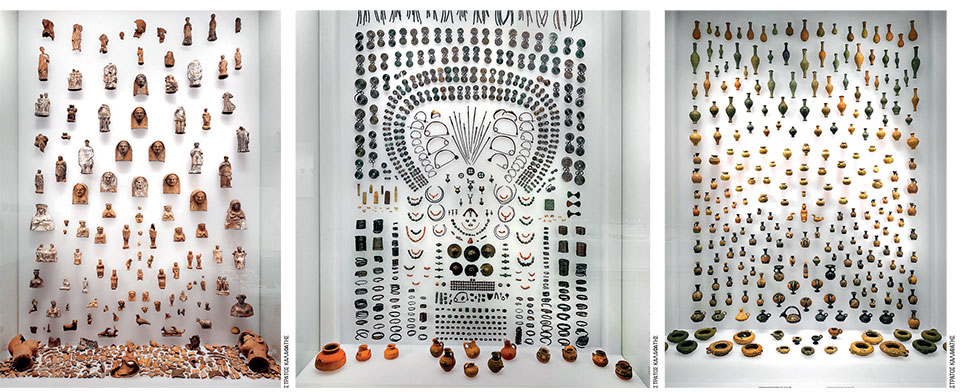
Fragments of destruction transform into stunning exhibits
“Memory of Aigai,” the main exhibition of the new museum, brings the ancient site to life. Small fragments from layers of destruction have impressively transformed into stunning exhibits “sharing their truth in a totally deductive environment, which respects and exalts them,” archaeologist and ephorate director Angeliki Kottaridi said. Fragments from layers of destruction reveal the identity of the ancient city, the life of the Macedonians, the precious everyday habits, the remains of a festival or the leftovers of a ceremony, the birth and the death of the palace – “the archetypal building that haunted the architecture of the Hellenistic world.”
Weapons of the Macedonians of Aigai, including bronze and iron swords, knives, spears and javelin heads, arrows and the remains of a sarissa (a spear some 4 to 6.5 meters long introduced by Philip II) that accompanied people in life and at death, kraters, jugs and cups used in symposiums, Hellenistic tiles bearing stamps, names of lords, ktetors, sponsors or officials, shards of glass and ivory, small nails from precious furniture, pieces of jewelry and tools, keys to temples and houses, make up the sub-themes of the exhibition.
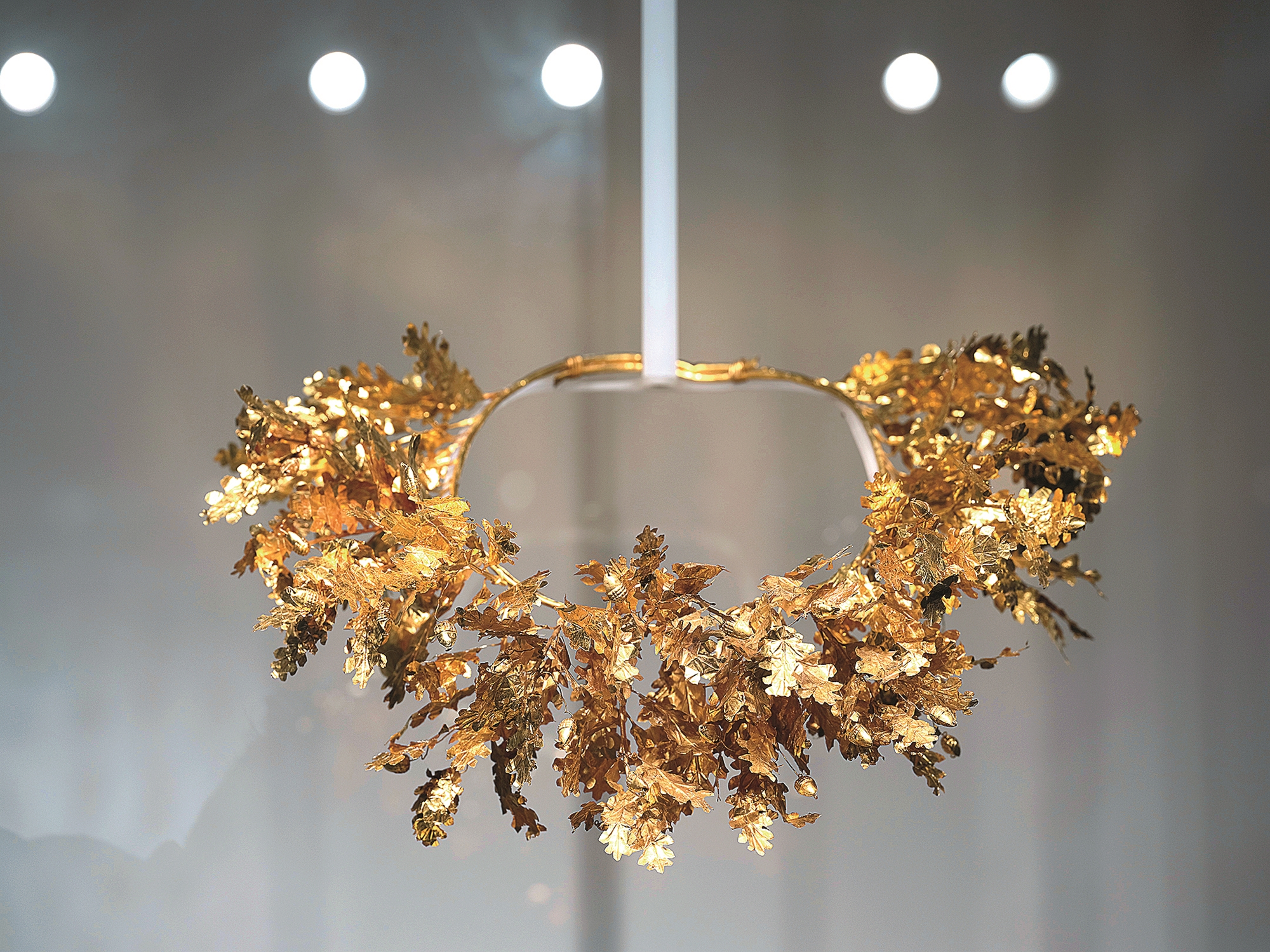
Elaborate objects offer a glimpse into the inner chambers of the palace, the lives behind closed doors, the self-care: women’s ornaments (jewelry, unguentaria, belt buckles, pins) and men’s ornaments, bottles of precious perfumes and ointments. And, finally, the Nekyia, with all that remains of the magnificent funeral pyres of the Temenids, the burial treasures, the traces of the symbols of their power. The gold-jeweled women’s costumes are shown near the close of the exhibition: 10 “Ladies of Aigai” accessorized with all sorts of jewelry. Mothers and wives, sisters and daughters, symbols and agents of power. It is no coincidence that these women used to sign or refer to themselves as men, with their father’s name and not their husband’s.
“Vergina does not end here,” Kottaridi says. The restoration of the archaeological and monumental legacy which at the same time preserves the memory and work of late archaeologist Manolis Andronikos (the new amphitheater is named after him) continues. It is a long-term project, “the fruit of a joint effort in recent years; because in culture there is no room for party divisions or narrow self-interest,” as the prime minister said. Mitsotakis admitted that “the number of people who visit Greece’s major cultural heritage sites remains low.” The new Polycentric Museum of Aigai, embracing one of the most famous and popular UNESCO monuments, aspires to increase those numbers.
